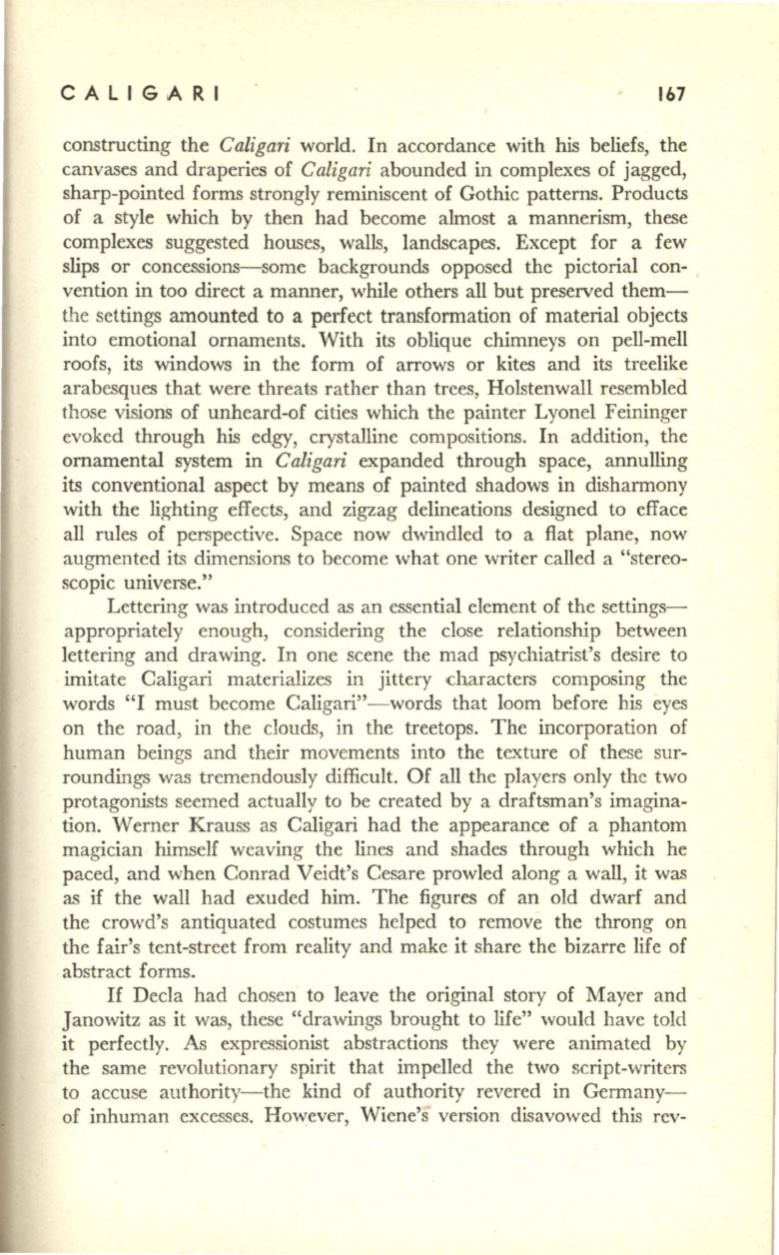
CALIGARI
167
constructing the
Caligari
world. In accordance with his beliefs, the
canvases and draperies of
Caligari
abounded in complexes of jagged,
sharp-pointed forms strongly reminiscent of Gothic patterns. Products
of a style which by then had become almost a mannerism, these
complexes suggested houses, walls, landscapes. Except for a few
slips or concessions-some backgrounds opposed the pictorial con–
vention in too direct a manner, while others all but preserved them–
the settings a."11ounted to a perfect transformation of material objects
into emotional ornaments. With its oblique chimneys on pell-mell
roofs, its windows in the form of arrows or kites and its treelike
arabesques that were threats rather than trees, Holstenwall resembled
those visions of unheard-of cities which the painter Lyonel Feininger
evoked through his edgy, crystalline compositions. In addition, the
ornamental system in
Caligari
expanded through space, annulling
its conventional aspect by means of painted shadows in disharmony
with the lighting effects, and zigzag delineations designed to efface
all rules of perspective. Space now dwindled to a flat plane, now
augmented its dimensions to become what one writer called a "stereo–
scopic universe."
Lettering was introduced as an essential element of the settings–
appropriately enough, considering the close relationship between
lettering and drawing. In one scene the mad psychiatrist's desire to
imitate Caligari materializes in jittery characters composing the
words "I must become Caligari"-words that loom before his eyes
on the road, in the clouds, in the treetops. The incorporation of
human beings and their movements into the texture of these sur–
roundings was tremendously difficult. Of all the players only the two
protagonists seemed actually to be created by a draftsman's imagina–
tion. Werner Krauss as Caligari had the appearance of a phantom
magician himself weaving the lines and shades through which he
paced, and when Conrad Veidt's Cesare prowled along a wall, it was
as if the wall had exuded him. The figures of an old dwarf and
the crowd's antiquated costumes helped to remove the throng on
the fair's tent-street from reality and make it share the bizarre life of
abstract forms.
If
Decla had chosen to leave the original story of Mayer and
Janowitz as it was, these "drawings brought to life" would have told
it perfectly. As expressionist abstractions they were animated by
the same revolutionary spirit that impelled the two script-writers
to accuse authority-the kind of authority revered in Germany–
of inhuman excesses. However, Wiene's version disavowed this rev-


